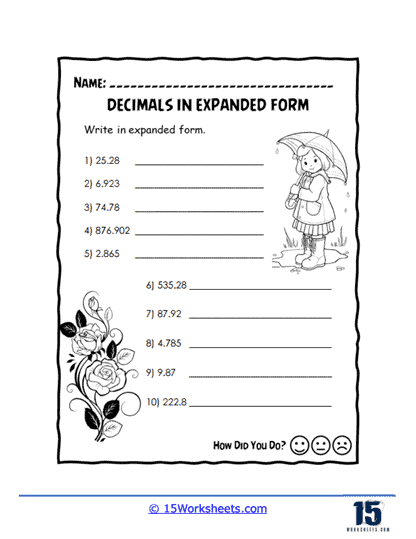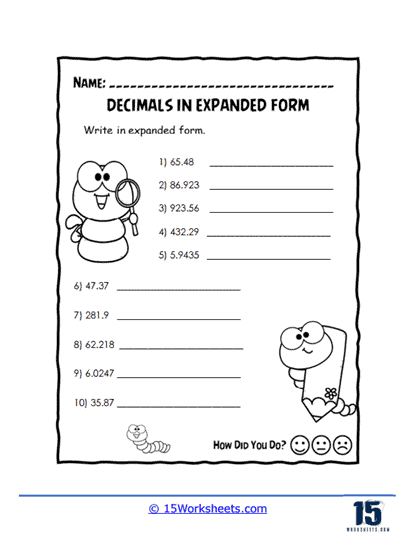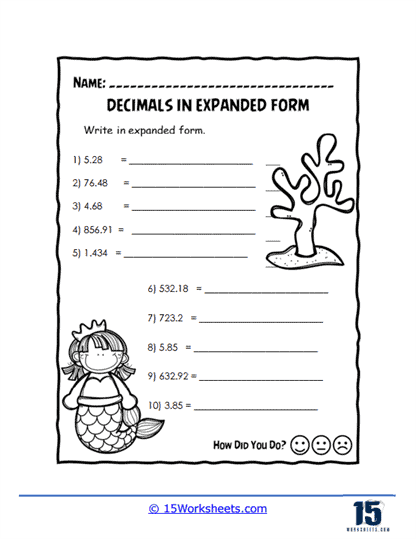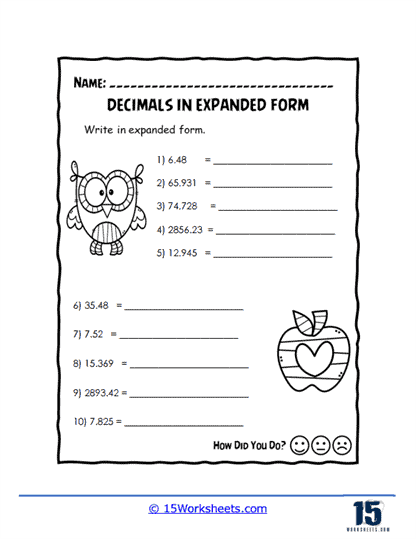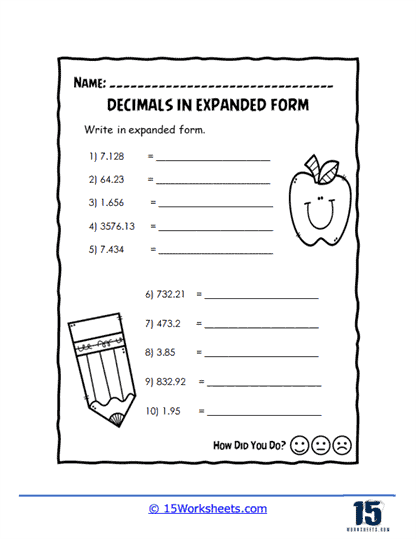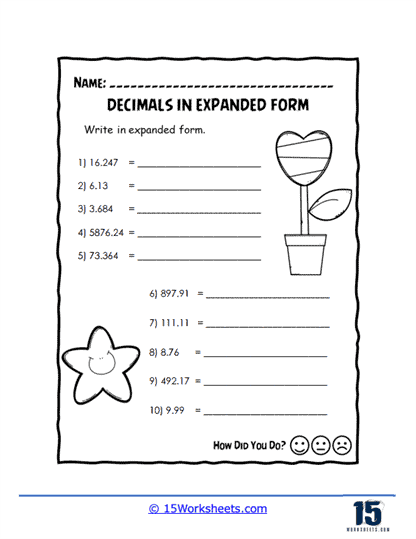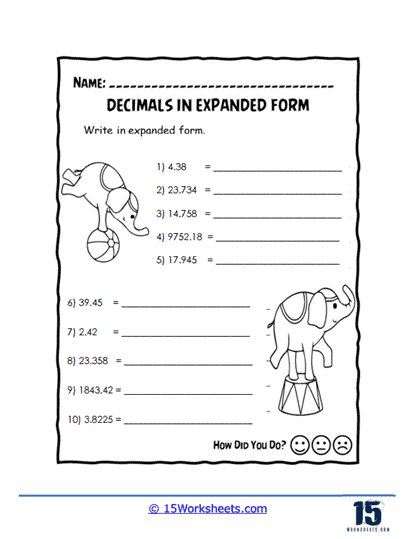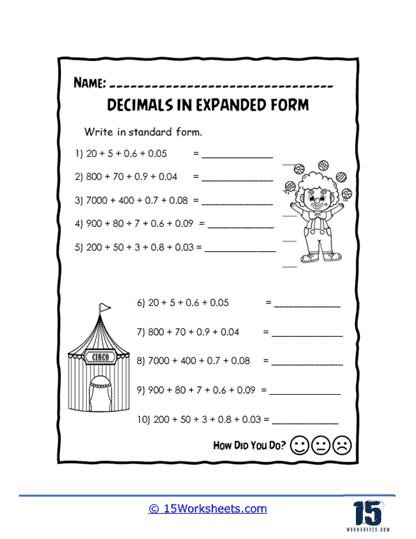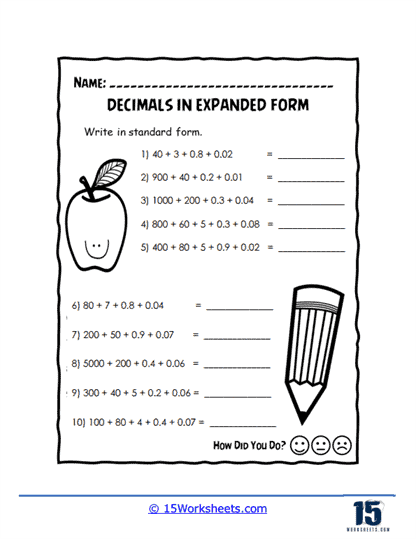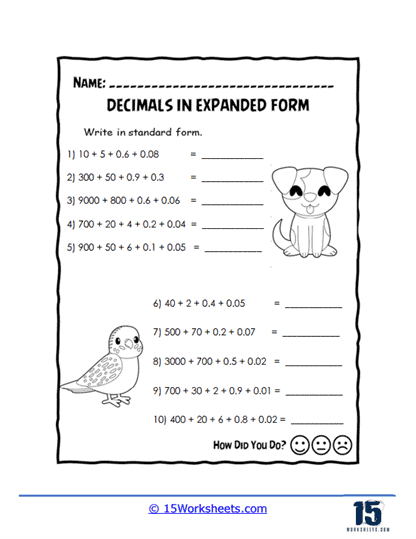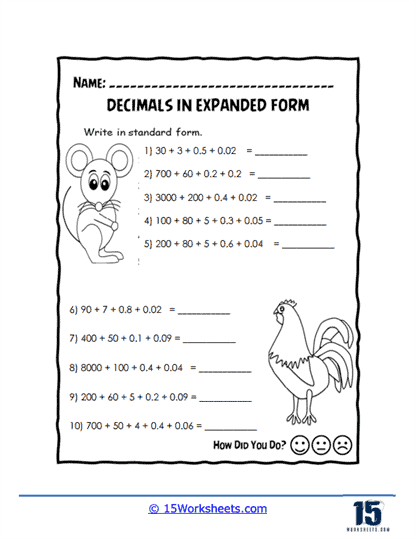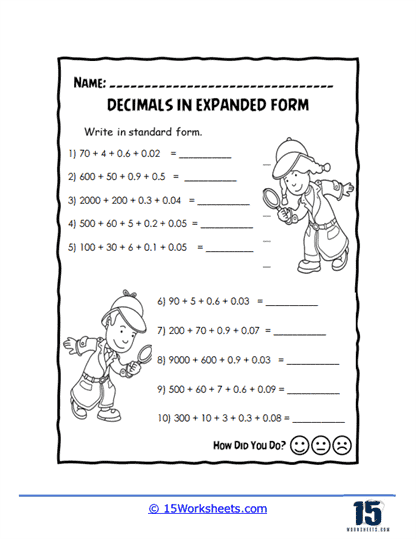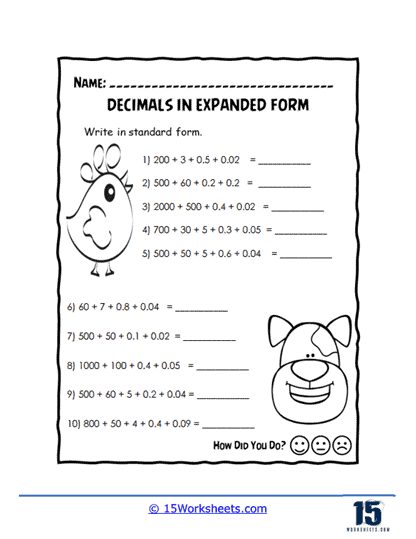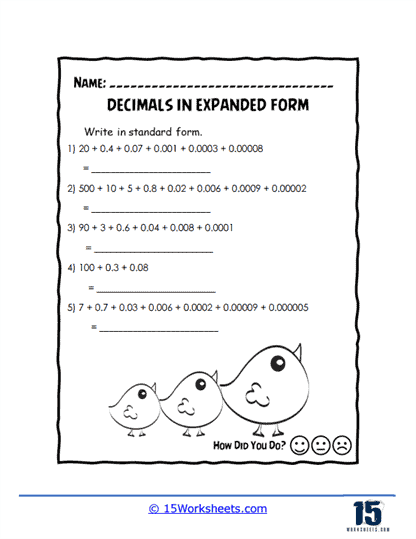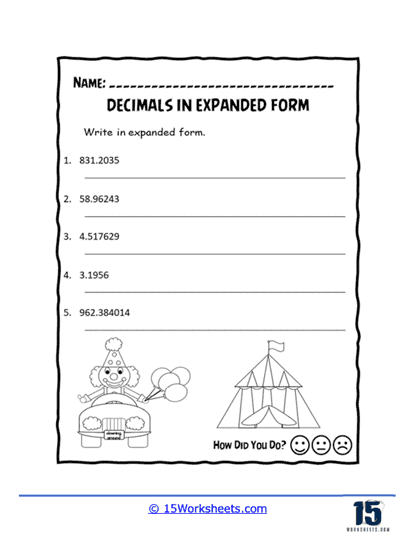Decimals to Expanded Form Worksheets
About These 15 Worksheets
These worksheets can be used to teach and reinforce the concept of representing decimal numbers in their expanded form. Expanded form is a way of breaking down numbers to show place value. For decimal numbers, it means expressing the number as the sum of each digit multiplied by its corresponding place value.
For example, the decimal 3.14 in expanded form would be written as 3 + 0.1 + 0.04, where 3 is in the ‘ones’ place, 1 is in the ‘tenths’ place, and 4 is in the ‘hundredths’ place.
Decimals to Expanded Form worksheets offer several types of exercises, each designed to progressively enhance a student’s understanding of decimal numbers and place value.
Conversion Exercises – These problems require students to convert decimal numbers into their expanded form. This is the most common type of problem and serves as the foundation for understanding this concept.
Reverse Conversion – In these exercises, students are given a number in expanded form and must convert it back into standard decimal notation. This allows students to fully understand the relationship between expanded form and the original decimal number.
Decimal Place Value Identification – These exercises help students identify the value of digits in decimal numbers. For example, in the number 45.67, what is the value of 6? (Answer – 6 is in the ‘hundredths’ place, so its value is 0.06.)
Word Problems – These exercises present real-world scenarios where students must convert decimal numbers into expanded form to solve the problem. This helps students understand the practical application of expanded form.
Comparison and Ordering – These exercises involve comparing and ordering decimals, which often requires understanding of the expanded form to correctly identify which decimal number is larger or smaller.
These exercises in the worksheets are designed not only to improve a student’s ability to work with decimal numbers, but also to enhance their overall math skills. Here’s how:
Understanding Place Value – By breaking down decimal numbers into their component parts, students gain a deeper understanding of the base-10 number system and the value of each digit in a number.
Enhancing Computation Skills – When students understand how numbers are constructed, they can perform arithmetic operations more effectively. It simplifies complex operations, making addition, subtraction, multiplication, and division of decimals easier to comprehend and execute.
Problem-Solving – Converting decimals to expanded form and vice versa, comparing and ordering decimals, and tackling word problems can all enhance problem-solving skills.
Critical Thinking – These exercises require careful thought and analysis, which can enhance critical thinking skills, beneficial for all areas of learning.
The skill of converting decimals to their expanded form and understanding place values has numerous practical applications in everyday life. When dealing with money, understanding the value of each digit is essential, with the first decimal place representing dimes and the second representing pennies. In science or engineering, understanding the decimal system and place values is crucial when dealing with measurements, especially those in metric units like kilograms and meters, which are based on powers of 10.
How Do You Convert a Decimal Value Into Expanded Form?
Converting a decimal value into its expanded form involves breaking down the decimal number into each digit’s value according to its place. Here is a step-by-step guide on how to do it:
Step 1) Identify the Value of Each Digit
Look at each digit in the decimal number and identify its value according to its position.
Remember that the first digit to the right of the decimal point is the ‘tenths’ place, the second digit to the right is the ‘hundredths’ place, the third digit is the ‘thousandths’ place, and so on. The first digit to the left of the decimal point is in the ‘ones’ place, the second digit to the left is in the ‘tens’ place, the third digit is in the ‘hundreds’ place, and so forth.
Step 2) Write Each Digit with Its Value
Write down each digit of the decimal number along with its corresponding place value. If you have the number 3.14, you would write it as – 3 (ones place) + 0.1 (tenths place) + 0.04 (hundredths place).
Step 3) Combine
Combine each part from step 2 to express the number in its expanded form. So, the decimal 3.14 in expanded form would be written as 3 + 0.1 + 0.04.
Please note that while writing down each digit with its value, the value is not merely the digit itself but the digit times its place value. For example, in the number 3.14, the digit 1 represents 1/10 or 0.1 because it is in the tenths place, and the digit 4 represents 4/100 or 0.04 because it is in the hundredths place.
Understanding and practicing this conversion process can be immensely beneficial in improving one’s grasp of the decimal number system and the underlying concept of place values. This skill also significantly aids in executing various arithmetic operations involving decimal numbers.
How Do You Convert a Decimal Value Into Expanded Form?
Converting a decimal value into its expanded form involves breaking down the decimal number into each digit’s value according to its place. Here is a step-by-step guide on how to do it:
Step 1 – Identify the Value of Each Digit
Look at each digit in the decimal number and identify its value according to its position.
Remember that the first digit to the right of the decimal point is the ‘tenths’ place, the second digit to the right is the ‘hundredths’ place, the third digit is the ‘thousandths’ place, and so on. The first digit to the left of the decimal point is in the ‘ones’ place, the second digit to the left is in the ‘tens’ place, the third digit is in the ‘hundreds’ place, and so forth.
Step 2 – Write Each Digit with Its Value
Write down each digit of the decimal number along with its corresponding place value. If you have the number 3.14, you would write it as – 3 (ones place) + 0.1 (tenths place) + 0.04 (hundredths place).
Step 3 – Combine
Combine each part from step 2 to express the number in its expanded form. So, the decimal 3.14 in expanded form would be written as 3 + 0.1 + 0.04.
Please note that while writing down each digit with its value, the value is not merely the digit itself but the digit times its place value. For example, in the number 3.14, the digit 1 represents 1/10 or 0.1 because it is in the tenths place, and the digit 4 represents 4/100 or 0.04 because it is in the hundredths place.
Understanding and practicing this conversion process can be immensely beneficial in improving one’s grasp of the decimal number system and the underlying concept of place values. This skill also significantly aids in executing various arithmetic operations involving decimal numbers.

